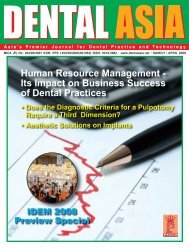Download - Dental Asia
Download - Dental Asia
Download - Dental Asia
You also want an ePaper? Increase the reach of your titles
YUMPU automatically turns print PDFs into web optimized ePapers that Google loves.
CLINICALFEATURE<br />
Table 1 Drug detection in saliva: Currently available methodolgy detects minute quantities of<br />
the following drugs and chemicals in saliva<br />
Therapeutic drugs<br />
Antipyrene<br />
Cyclosporin<br />
Digoxin<br />
Mathadone<br />
Paracetamol<br />
Quinine<br />
Carbamazepine<br />
Diazepam<br />
Lithium<br />
Oxprenolol<br />
Phenytoin<br />
Tolbutamide<br />
Recreational drugs and drugs of abuse<br />
Amphetamines<br />
Benzodiazepines<br />
Cocaine<br />
Nicotine<br />
Barbiturates<br />
Ethanol<br />
Marijuana<br />
Opioids<br />
Phencyclidine<br />
screened the saliva again to see how often they could correctly<br />
identify the samples from the cancer patients. The group could<br />
identify the saliva from cancer patients in nine out of 10 samples.<br />
Although this is a primary, exploratory study the data is exciting<br />
and paves way to further research in the direction. Previoulsy,<br />
Boyle et al. 34 , have shown the possible value of p53 in saliva as a<br />
marker for squamous cell carcinoma. Interestingly, they detected<br />
and identified tumor-specific mutations in p53 in preoperative<br />
salivary samples of individuals suffering from head and neck<br />
squamous cell carcinoma.<br />
Apart from these more recent molecular studies many have<br />
investigated the utility of proteins in saliva for the detection of<br />
systemic, non oral, malignancies. These results indicate that,<br />
for instance, higher levels of salivary kallikrein in patients with<br />
malignant tumors as compared with those with benign tumors<br />
or from healthy controls. Others have also shown that saliva<br />
contains the cancer antigen CA 125, a glycoprotein complex<br />
that is an often-used marker for ovarian cancer. Indeed<br />
according to some studies salivary CA 125 assay had a better<br />
diagnostic value than the comparable serum assay 35 .<br />
Saliva has also been used for monitoring patient response to<br />
chemotherapy for breast cancer or surgical treatment of the<br />
disease. Thus Streckfus et al. 36 , studied the protein product of<br />
the oncogene c-erbB-2, also known as HER-2/neu, and noted<br />
that it is elevated in the saliva of women diagnosed with<br />
breast cancer. In earlier studies, it has also been shown that<br />
the epidermal growth factor (EGF) is higher in the saliva of<br />
women with primary breast cancer or a recurrence of breast<br />
cancer when compared with women without disease 37 .<br />
The foregoing clearly illustrates the potential of salivary<br />
diagnostics in the management of both oral and non-oral<br />
malignancies. In particular, the salivary proteomic and mRNA<br />
studies and those in current development 38 including<br />
electrochemical enzyme immunoassay procedures 39 have the<br />
greatest promise in this regard.<br />
Hereditary Disorders<br />
Attempts have been made by several investigators to use<br />
saliva as a diagnostic fluid for hereditary diseases such as<br />
cystic fibrosis (CF), celiac disease and 21-Hydroxylase<br />
deficiency - an inherited disorder of steroidogenesis.<br />
However, these have been met with partial success.<br />
Drug Monitoring<br />
Various drugs taken internally either for medicinal or<br />
recreational purposes can appear in saliva. However, the<br />
salivary drug concentration is influenced by the molecular and<br />
physicochemical characteristics of the drug and its interaction<br />
with the salivary tissues, as well as the extravascular drug<br />
metabolism. Additionally salivary factors including the<br />
presence of food debris, sloughed epithelial cells, and pH<br />
determine the drug availability 40 . More improved saliva<br />
collection methods and preservatives that maintain the<br />
integrity have largely overcome these problems however.<br />
Monitoring of illicit drug use by salivary detection methods<br />
appears to be the most promising in this context. Currently,<br />
saliva can be used to detect opioids, barbiturates,<br />
22 <strong>Dental</strong> <strong>Asia</strong> • May / June 2008





